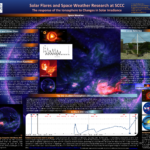
Medium resolution image of Professor Madigan’s Exhibit, highlighting and showcasing his ongoing research. Click the image to download this medium-resolution image. Additional download options are available below.
Full resolution image (2624 x 2250) is available for download here
Space Weather
Some conditions in space have the potential to seriously affect life on Earth. We call these conditions “Space Weather”. The effects of the solar wind, either as the continuous, daily stream of charged particles bombarding the Ionosphere, the upper, tenuous region of the Earth’s atmosphere or as the result of a solar flare, can be measured. An aspect of Space Weather, this interaction with the Ionosphere above 85 kilometers in altitude produces the beautiful auroral displays we observe as the Northern and Southern Lights. Another aspect of Space Weather, and one that is central to this research, is the response of the E and F layers of the Ionosphere to the daily irradiance of high-energy solar radiation, predominantly solar ultraviolet. In short, the lower D layer of the Ionosphere is produced by the ionization of the E and F layers during the day; at night, the electrons and ions quickly recombine in the absence of solar irradiance and the D layer disappears. This ionization and its effects can be measured and quantified by the interaction of VLF (very low frequency) radio waves with these layers and is at the heart of this research. Compared to the charged particles of the solar wind which take 2 or 3 days to reach the Earth, X-rays and ultraviolet radiation travel at the speed of light and take a little over 8 minutes to reach the Earth, so their effects on the Ionosphere can be measured and observed within minutes of occurring on the sun.
The Sun and other stars
 The Sun and all stars are dynamic, self-regulating systems, each powered by a huge nuclear fusion reactor in their core. These cores of the sun and other stars in a similar evolutionary state currently produce helium and a tremendous amount of energy. From the 15 million-degree core plasma produced by these nuclear fusion reactors flows a stream of protons, electrons and helium nuclei, collectively referred to as the solar wind.
The Sun and all stars are dynamic, self-regulating systems, each powered by a huge nuclear fusion reactor in their core. These cores of the sun and other stars in a similar evolutionary state currently produce helium and a tremendous amount of energy. From the 15 million-degree core plasma produced by these nuclear fusion reactors flows a stream of protons, electrons and helium nuclei, collectively referred to as the solar wind.
Solar Activity
 Sunspot numbers are an indicator of internal solar activity; increased sunspot numbers are an indicator of increased solar output and activity. Our sun has an 11-year activity cycle. Currently, solar activity is waning. Considering the sun’s nature as a giant, roiling, self-regulating ball of super-heated plasma that is modeled as a fluid, we expect certain irregularities in the sun’s behavior and activity, aspects of solar dynamics that give rise to solar storms and outbursts, phenomenae whose frequency of occurrence are directly linked to the solar cycle.
Sunspot numbers are an indicator of internal solar activity; increased sunspot numbers are an indicator of increased solar output and activity. Our sun has an 11-year activity cycle. Currently, solar activity is waning. Considering the sun’s nature as a giant, roiling, self-regulating ball of super-heated plasma that is modeled as a fluid, we expect certain irregularities in the sun’s behavior and activity, aspects of solar dynamics that give rise to solar storms and outbursts, phenomenae whose frequency of occurrence are directly linked to the solar cycle.
Solar Flares vs Coronal Mass Ejections
While they are both indicative of a dynamic and changing environment, they are, at the same time, quite different in nature, yet have certain commonalities. A CME is a huge bubble of magnetized gas that is ejected into space, an event that may take several hours to complete. A solar flare is far more temporal and short-lived and much smaller in scale. They both have associated with them streams of high-energy protons, electrons and alpha particles (helium nuclei). Hence, the large difference between solar flares and CMEs is mostly one of size. Both can occur together but can also occur in the absence of the other.
Solar Flares
Million-degree gas produces X-rays; solar flares, short-lived and temporal, are often associated with sunspots, cooler regions of the sun’s photosphere resulting from magnetic anomalies that cause a breach in energy transmission from the solar interior. Solar flares emit radiation in the visible, the ultraviolet, x-ray and gamma ray regimes of the electromagnetic spectrum. The X-rays and gamma rays, being of the highest energy, are associated with localized, super-heated gas. Solar flares are thus categorized according to a logarithmic x-ray intensity scale from A being the weakest to X being the strongest. The measured flux at the Earth/Sun distance is
A = 1.0×10-8 (Watts m-2)
B = 1.0×10-7 (Watts m-2)
C = 1.0×10-6 (Watts m-2)
M = 1.0×10-5 (Watts m-2)
X = 1.0×10-4 (Watts m-2)
Units: Watts/sq. meter
The SID (Sudden Ionospheric Disturbance) Effect
A SID is the result of a rapid influx of high-energy ultraviolet or x-ray radiation. Although this radiation is most often attributed to the sun, the source could theoretically originate in deep space from supernovae or a Gamma Ray Burst. One method of detecting SIDs involves measuring the effect Ionospheric changes have on reflected VLF (very low frequency, 3 – 30 Khz) radio signals. When a solar flare occurs, high-energy X-rays irradiate the sunlit side of the Earth, striking the E and F layers of the Ionosphere. These X-rays will penetrate to the D-layer, releasing electrons that will rapidly increase absorption, causing VLF (3 – 30 kHz) signals to be reflected by the D layer where the increased atmospheric density will usually increase the absorption of the signal and thus dampen it. This effect is clearly observed in our data. As soon as the flare ends, the X-rays abate and the SID ends as the electrons and ions in the D-region recombine rapidly and the signal strengths return to normal.
11 March 2015 Solar Flare
Evidence of an X-class event in progress is captured at SCCC and recorded as a SID event. Beginning with the first spike, it is immediately observed at 16:10 UT with almost complete signal attenuation at 17:00 UT. This is followed by an M-class event at 18:40 UT. The difference in magnitude of both events is clearly evident: the X class event almost completely suppresses the signal with the ionosphere D-level recovery presenting as a characteristic tail which then flows into the M class event that presents in a similar manner but smaller in magnitude. Local sunrise and sunset are indicated by the light blue arrows at 11:00 UT and 23:00 UT respectively. The X-class event and the M-class event had a measured X-ray flux of 2.1×10-4 Watts/m2 and 1.0×10-5 Watts/m2 respectively. Received signal strength is measured as a function of time: http://sdoisgo.blogspot.com/2015/03/the-first-x-class-flare-of-2015.html
Corresponding Composite 11th March, 2015
The flare that produced the SID illustrated. Images obtained from the orbiting Solar Dynamics Observatory at 16:56 UT at the Extreme Ultraviolet (EUV) wavelengths of 94, 193 and 335 Angstroms. To get a sense of scale at just how small these wavelengths are, yellow-green light has a wavelength of 5,000 Angstroms. 1 Angstrom = 0.1 nanometers (1.0×10-10 meters) or 1/500,000 (1/2 million) times smaller than the width of a human hair.
Background Image
Composite image from the orbiting Solar Dynamics Observatory recording an M-class solar flare at 03:08 UT, 15th March, 2015 at the Extreme Ultraviolet (EUV) wavelengths of 94, 193 and 335 Angstroms.
SCCC Loop Antenna
 In 2007, through a grant obtained by the SCCC Physical Sciences Department, Professor Thomas Madigan built the 2 meter “loop wire” antenna mounted atop the Smithtown Science Building. The antenna is connected to a VLF (3 – 30 Khz) receiver, which, in turn, is connected to a dedicated computer. At 00:00 UT (8:00 PM) every day, the data is uploaded to Stanford University’s Solar Center for inclusion in their worldwide database. Visit sid.stanford.edu, click data and select “SFCC” as the site ID to view the college’s daily results, for more information or to get involved. For the Stanford Solar Center’s home page, visit: solar-center.stanford.edu.
In 2007, through a grant obtained by the SCCC Physical Sciences Department, Professor Thomas Madigan built the 2 meter “loop wire” antenna mounted atop the Smithtown Science Building. The antenna is connected to a VLF (3 – 30 Khz) receiver, which, in turn, is connected to a dedicated computer. At 00:00 UT (8:00 PM) every day, the data is uploaded to Stanford University’s Solar Center for inclusion in their worldwide database. Visit sid.stanford.edu, click data and select “SFCC” as the site ID to view the college’s daily results, for more information or to get involved. For the Stanford Solar Center’s home page, visit: solar-center.stanford.edu.
 Page Featured image produced by the Solar Dynamics Observatory (SDO): composite of the sun in extreme UltraViolet and soft X-Rays (respective wavelengths: 9.4 nm, 19.3 nm and 33.5 nm) on 22 October, 2014. The bright, illuminated (and “flaring” – bright red-pink) regions of the sun that appear in this image are over six million degrees, so hot that iron has been ionized between 11 and 17 times!
Page Featured image produced by the Solar Dynamics Observatory (SDO): composite of the sun in extreme UltraViolet and soft X-Rays (respective wavelengths: 9.4 nm, 19.3 nm and 33.5 nm) on 22 October, 2014. The bright, illuminated (and “flaring” – bright red-pink) regions of the sun that appear in this image are over six million degrees, so hot that iron has been ionized between 11 and 17 times!


